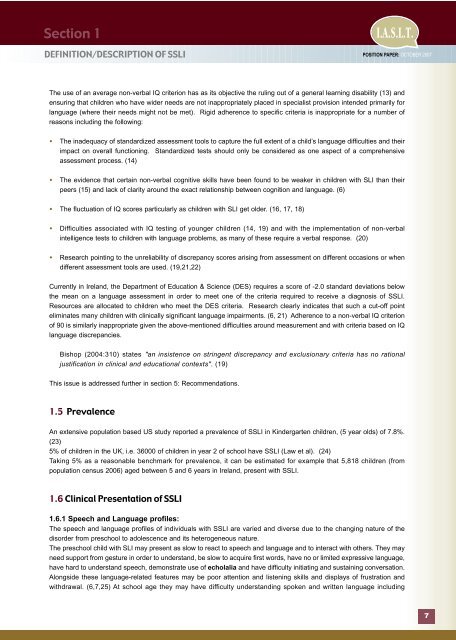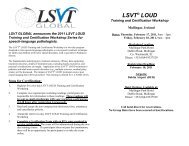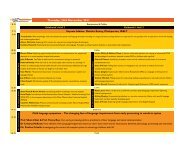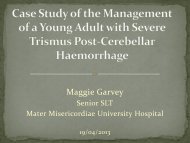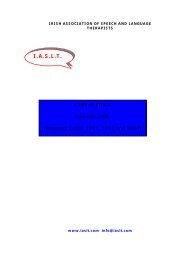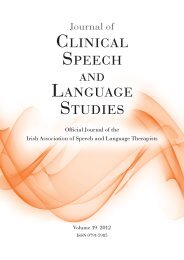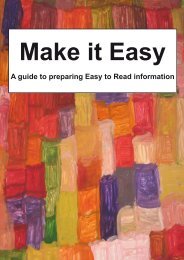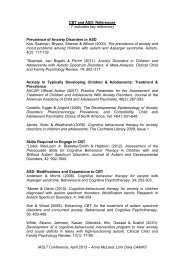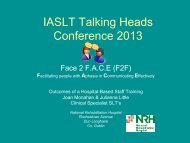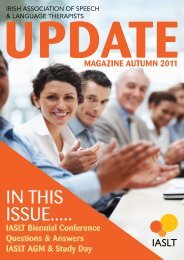Specific Speech and Language Impairment in Children - Irish ...
Specific Speech and Language Impairment in Children - Irish ...
Specific Speech and Language Impairment in Children - Irish ...
- No tags were found...
Create successful ePaper yourself
Turn your PDF publications into a flip-book with our unique Google optimized e-Paper software.
Section 1DEFINITION/DESCRIPTION OF SSLII.A.S.L.T.POSITION PAPER: OCTOBER 2007The use of an average non-verbal IQ criterion has as its objective the rul<strong>in</strong>g out of a general learn<strong>in</strong>g disability (13) <strong>and</strong>ensur<strong>in</strong>g that children who have wider needs are not <strong>in</strong>appropriately placed <strong>in</strong> specialist provision <strong>in</strong>tended primarily forlanguage (where their needs might not be met). Rigid adherence to specific criteria is <strong>in</strong>appropriate for a number ofreasons <strong>in</strong>clud<strong>in</strong>g the follow<strong>in</strong>g:• The <strong>in</strong>adequacy of st<strong>and</strong>ardized assessment tools to capture the full extent of a child’s language difficulties <strong>and</strong> theirimpact on overall function<strong>in</strong>g. St<strong>and</strong>ardized tests should only be considered as one aspect of a comprehensiveassessment process. (14)• The evidence that certa<strong>in</strong> non-verbal cognitive skills have been found to be weaker <strong>in</strong> children with SLI than theirpeers (15) <strong>and</strong> lack of clarity around the exact relationship between cognition <strong>and</strong> language. (6)• The fluctuation of IQ scores particularly as children with SLI get older. (16, 17, 18)• Difficulties associated with IQ test<strong>in</strong>g of younger children (14, 19) <strong>and</strong> with the implementation of non-verbal<strong>in</strong>telligence tests to children with language problems, as many of these require a verbal response. (20)• Research po<strong>in</strong>t<strong>in</strong>g to the unreliability of discrepancy scores aris<strong>in</strong>g from assessment on different occasions or whendifferent assessment tools are used. (19,21,22)Currently <strong>in</strong> Irel<strong>and</strong>, the Department of Education & Science (DES) requires a score of -2.0 st<strong>and</strong>ard deviations belowthe mean on a language assessment <strong>in</strong> order to meet one of the criteria required to receive a diagnosis of SSLI.Resources are allocated to children who meet the DES criteria. Research clearly <strong>in</strong>dicates that such a cut-off po<strong>in</strong>telim<strong>in</strong>ates many children with cl<strong>in</strong>ically significant language impairments. (6, 21) Adherence to a non-verbal IQ criterionof 90 is similarly <strong>in</strong>appropriate given the above-mentioned difficulties around measurement <strong>and</strong> with criteria based on IQlanguage discrepancies.Bishop (2004:310) states "an <strong>in</strong>sistence on str<strong>in</strong>gent discrepancy <strong>and</strong> exclusionary criteria has no rationaljustification <strong>in</strong> cl<strong>in</strong>ical <strong>and</strong> educational contexts". (19)This issue is addressed further <strong>in</strong> section 5: Recommendations.1.5 PrevalenceAn extensive population based US study reported a prevalence of SSLI <strong>in</strong> K<strong>in</strong>dergarten children, (5 year olds) of 7.8%.(23)5% of children <strong>in</strong> the UK, i.e. 36000 of children <strong>in</strong> year 2 of school have SSLI (Law et al). (24)Tak<strong>in</strong>g 5% as a reasonable benchmark for prevalence, it can be estimated for example that 5,818 children (frompopulation census 2006) aged between 5 <strong>and</strong> 6 years <strong>in</strong> Irel<strong>and</strong>, present with SSLI.1.6 Cl<strong>in</strong>ical Presentation of SSLI1.6.1 <strong>Speech</strong> <strong>and</strong> <strong>Language</strong> profiles:The speech <strong>and</strong> language profiles of <strong>in</strong>dividuals with SSLI are varied <strong>and</strong> diverse due to the chang<strong>in</strong>g nature of thedisorder from preschool to adolescence <strong>and</strong> its heterogeneous nature.The preschool child with SLI may present as slow to react to speech <strong>and</strong> language <strong>and</strong> to <strong>in</strong>teract with others. They mayneed support from gesture <strong>in</strong> order to underst<strong>and</strong>, be slow to acquire first words, have no or limited expressive language,have hard to underst<strong>and</strong> speech, demonstrate use of echolalia <strong>and</strong> have difficulty <strong>in</strong>itiat<strong>in</strong>g <strong>and</strong> susta<strong>in</strong><strong>in</strong>g conversation.Alongside these language-related features may be poor attention <strong>and</strong> listen<strong>in</strong>g skills <strong>and</strong> displays of frustration <strong>and</strong>withdrawal. (6,7,25) At school age they may have difficulty underst<strong>and</strong><strong>in</strong>g spoken <strong>and</strong> written language <strong>in</strong>clud<strong>in</strong>g7


